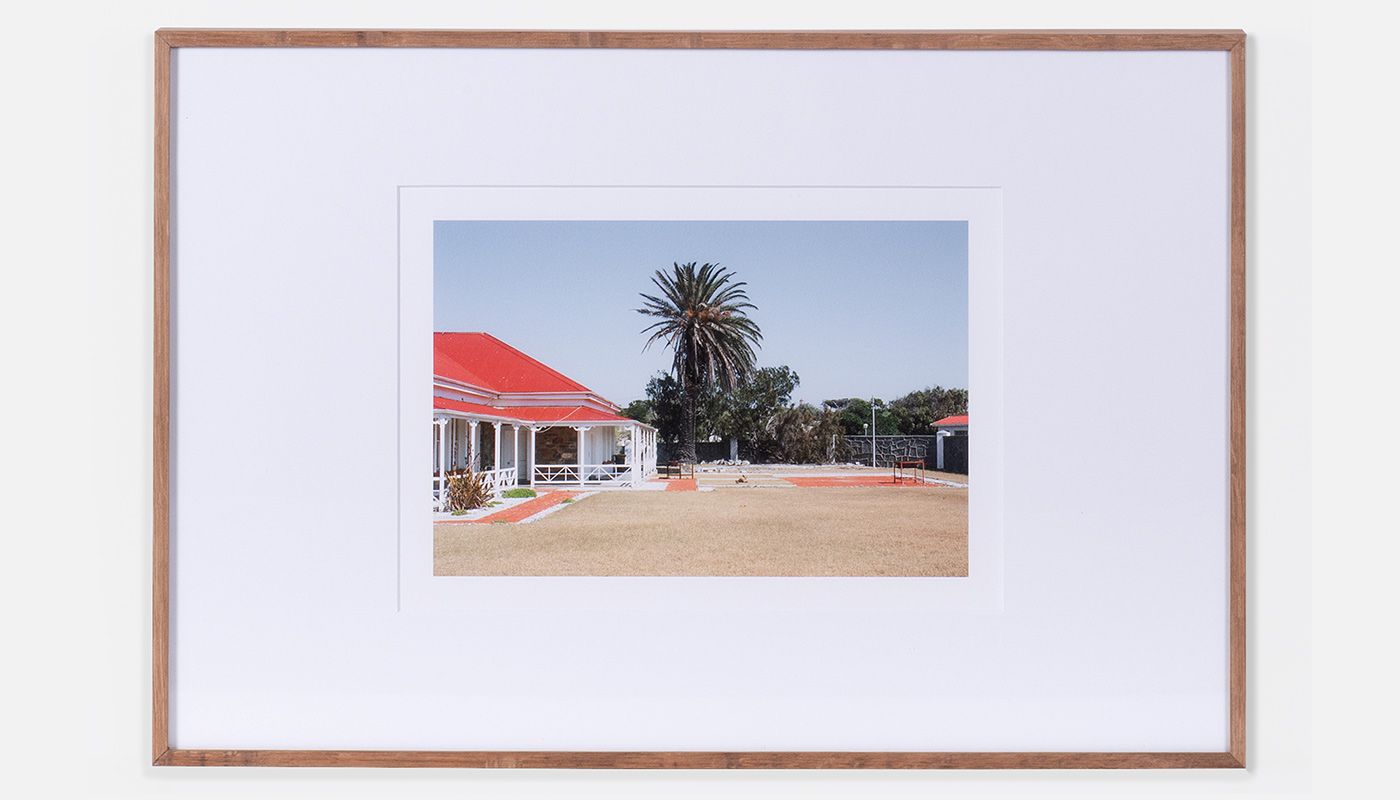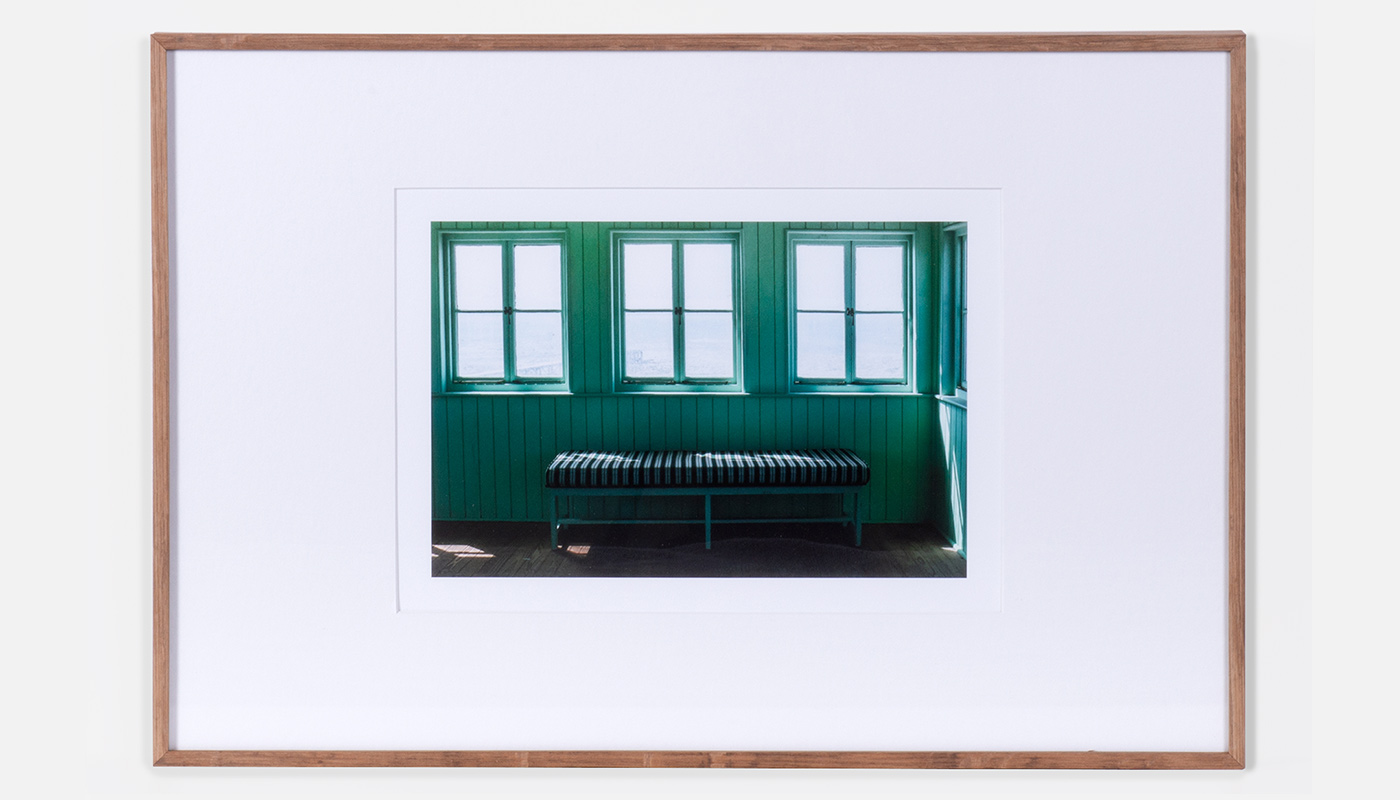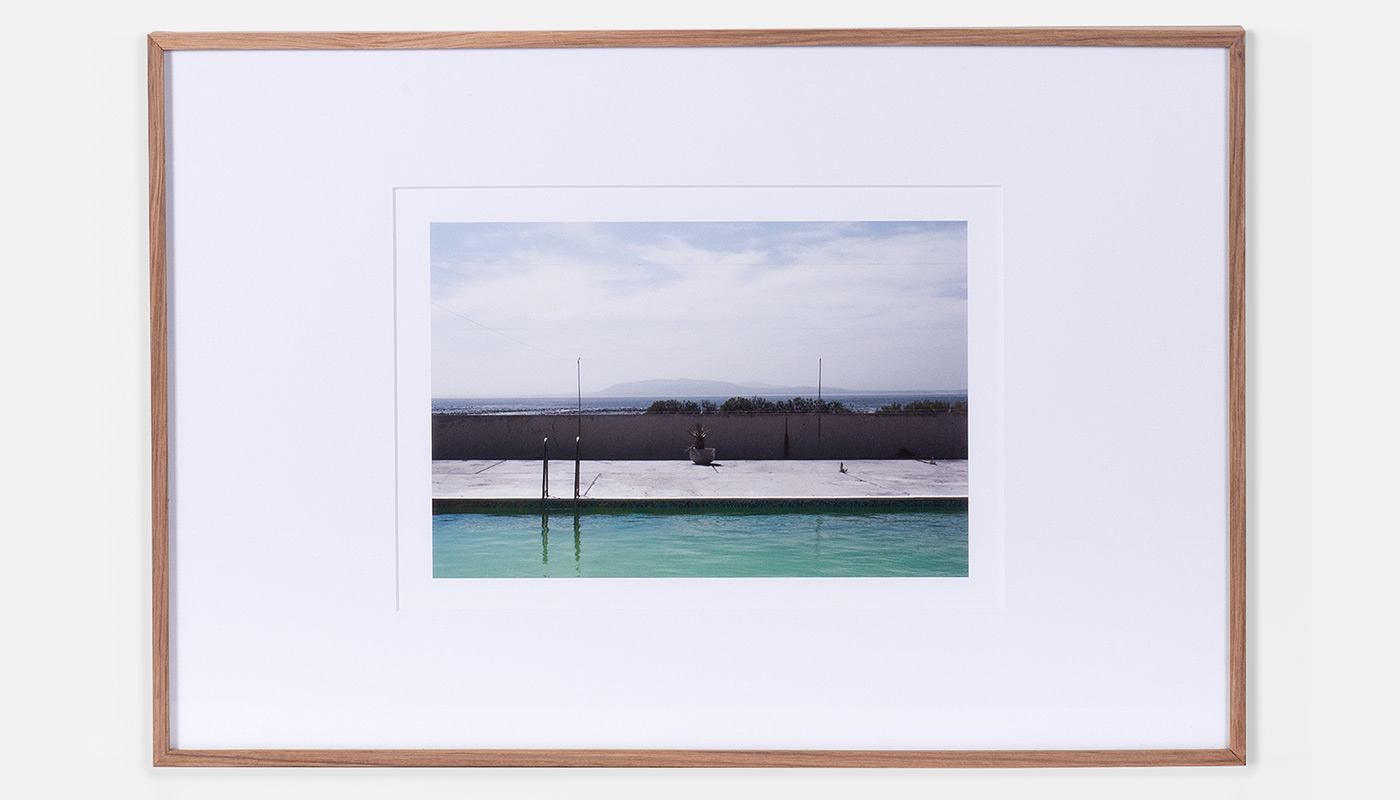READ:
COLOURED SOMAS

In 2010, I visited Robben Island for the first time since I had left my family home fifteen years before. I returned to the places I remembered from my childhood spent on the Island, the graveyard, the guest house, the windswept rocks. Arriving at the communal swimming pool, I discovered a flock of dead seagulls floating in the water. The pool, left unkept, mimicked the dark green-blue sea just on the other side of the wall.
I was twenty years old. Soon after I visited, I read an account of two men, Rijkaart Jacobs and Claas Blank, who were drowned off the coast of Robben Island in the early eighteenth century. They were sentenced to death on charges of having a homosexual relationship, though the term homosexual did not yet exist.
The drowned men and the dead seagulls, the familiar rocking of the boat, my return to that place, together became a catalyst to reconnect with the Island, with my childhood and identity, the swimming pool, the sea, the land, and loss. The Island revealed itself not only as a site of national significance but one charged with personal resonance, a place that persists in my memory as both a physical and psychological landscape.
The drowned men and the dead seagulls, the familiar rocking of the boat, my return to that place, together became a catalyst to reconnect with the Island, with my childhood and identity, the swimming pool, the sea, the land, and loss. The Island revealed itself not only as a site of national significance but one charged with personal resonance, a place that persists in my memory as both a physical and psychological landscape.

The first years of my life (1989 to 1995) were spent on Robben Island. While it was a safe place for children to wander freely, a suburban idyll of sorts, it was a prison to many of its residents. Apartheid South Africa, however, was coming undone – soon prisoners would leave and so too would the children. The year 1994 was the start of new beginnings on the mainland: for the warders and their families who lived on the Island; and for the many political prisoners who had been exiled there.
I do not recall when I first realised the historical weight that my childhood island carried, and the fate it promised for many people who were banished there. Innocent family photos of birthday parties and days spent by the swimming pool are haunted by the realities of the time. The enormity of the Island’s violent past exists alongside my personal relationship to that burdened space; it is the unspoken presence in much of my work as in my memories.
Confronting the weight of the history of the Island, I find it is not possible to write a linear, sequential narrative that suggests neat connections and solutions to my entanglement with it. My work asks to be read and viewed in a series of fragments which connect in less defined and absolute ways.
I touch on ideas of queerness, violence, desire and the uncertain symbol of the sea. There is an ode to blue, a pink flag, golden foil, green tiles. There are those who have come before me, whose writing I return to – Derek Jarman, Virginia Woolf, Jean Genet. There are artists and their scenes of hope and isolation. There are cries of “crucify!” and furtive hands unbuckling belts.
I do not recall when I first realised the historical weight that my childhood island carried, and the fate it promised for many people who were banished there. Innocent family photos of birthday parties and days spent by the swimming pool are haunted by the realities of the time. The enormity of the Island’s violent past exists alongside my personal relationship to that burdened space; it is the unspoken presence in much of my work as in my memories.
Confronting the weight of the history of the Island, I find it is not possible to write a linear, sequential narrative that suggests neat connections and solutions to my entanglement with it. My work asks to be read and viewed in a series of fragments which connect in less defined and absolute ways.
I touch on ideas of queerness, violence, desire and the uncertain symbol of the sea. There is an ode to blue, a pink flag, golden foil, green tiles. There are those who have come before me, whose writing I return to – Derek Jarman, Virginia Woolf, Jean Genet. There are artists and their scenes of hope and isolation. There are cries of “crucify!” and furtive hands unbuckling belts.

Unlike Jacobs and Blank, I live in a constitutionally free society protected from discrimination based on race, colour and sexual orientation – in theory, if not in practice. As a self-recognised gay man, I form part of the first generation of South African LGBTQI+ community who cannot be discriminated against by law. This reassurance, however, is bitter-sweet. There is no law to protect those among us who still end up as society’s cast-offs. Freedom is not a given but a slow negotiation.
Exploring, or rather testing, this new freedom, my research had led me to past events, literature, film and art, only to find that no happy ending has been paved out for the LGBTQI+ community to follow. More often than not, those works I have engaged with conclude under the shadow of discrimination, exile, illness, death and existential heartbreak. They are a reflection and product of experience, governing laws and queer histories. The need and desire for companionship, acceptance and happiness are palpably evident in gay literature and film. However, it seems as though these wants and desires are seldom allowed. One need only to investigate the writings of Edmund White, Allan Hollinghurst and Jean Genet to see this pattern of unfulfilled needs.
Within my work, I turn to themes of gay experience and culture that has been explored by a selection of authors, film-makers and artists. I reflect on ideas around illusory happiness, following a visual expression of the gay body’s relationship with the island, the sea and the swimming pool, which extends to – include spaces such as bathhouses and locker rooms – so often settings in gay films and literature. These spaces allude to desire, attraction and eroticism, as a place where nude male bodies intersect and meet behind closed doors, hidden by curtains or left unseen within steam-filled rooms. Beyond these spaces lies a darker social reality laced with violence – with illness, judgement, discrimination, incarceration and exile.

Among the writers I have turned to in exploring these themes, is the South African author, Damon Galgut. His role in my research and writing is perhaps oblique, as he makes no particular reference to either swimming pools or the sea. In his novel The Imposter (2009), however, he describes an ongoing battle with a weed-filled garden, a story I read as an analogy of the narrator’s struggle with life and identity. Scenes borrowed from Galgut’s garden reflect and respond to the description of the artist Derek Jarman’s seaside garden on the English coast.
Jarman is a recurring figure throughout my work and writing, and I return often to his images and words, to his film of blue and to his journal entries. Both offer insight into the last years of his life spent living by the sea, tending to his garden, and witnessing friends die from the same illness that would later claim his life. Most present in my work is Jarman’s Chroma (1994), a book dedicated to colour, which he wrote as he began losing his sight.
Like Jarman’s journal entries, South African artist Adriaan van Zyl’s paintings of hospital scenes and seascapes record his experience of illness and imminent death. However, Van Zyl also offers the viewer innocent memory, nostalgia and desire through his Bather series of swimming pool changing rooms. These scenes, both of the sea and changing rooms, carry a memory – they evoke the many boat rides I took as a child between Robben Island and the mainland, and the Long Street pools where my partner and I have swum these past years.
David Hockney, too, finds a forbidden desire and pleasure in damp places – swimming pools, changing rooms and shower scenes. In A Bigger Splash (1967), the figure that plunges into the pool will never surface, frozen forever in that mottled blue. Within his work, Hockney captures and stills the movement of water and male bodies, to be viewed like this – forever.
Other artists who recur in my work are Danh Vo and Bill Viola – Vo for his origin story, and Viola for his images of drowning. As a young child, Vo and his family fled Vietnam by boat. His flight and rescue at sea, and work, have deeply influenced my impressions of the sea – a place of both hope and peril. “The sea, unlike the land, cannot be marked but is restless, always moving –” writes Virginia Woolf in The Waves (1933). Woolf’s drowning, visually narrated in the film The Hours, has lent me an image of fragility, sacrifice and the submerged body. This idea is amplified in Bill Viola’s video and sound work The Arc of Ascent (1992), which places the viewer and listener in the space of the living, witnessing another body’s violent experience of drowning and suffocating. Viola’s film distracts the viewer from the subject’s distress, by mesmerising the viewer with the sound of water, and images of light, colour and floating fabric around a submerged and suspended form.
In Jean Genet’s Querelle de Brest (1953), the sea meets land, a ship of sailors docks at a French port city, and Genet delivers a perfect combination of violence, desire and love: confusing beauty and brutality for the reader. Murder, sex and freedom become intertwined and synonymous.
Jarman is a recurring figure throughout my work and writing, and I return often to his images and words, to his film of blue and to his journal entries. Both offer insight into the last years of his life spent living by the sea, tending to his garden, and witnessing friends die from the same illness that would later claim his life. Most present in my work is Jarman’s Chroma (1994), a book dedicated to colour, which he wrote as he began losing his sight.
Like Jarman’s journal entries, South African artist Adriaan van Zyl’s paintings of hospital scenes and seascapes record his experience of illness and imminent death. However, Van Zyl also offers the viewer innocent memory, nostalgia and desire through his Bather series of swimming pool changing rooms. These scenes, both of the sea and changing rooms, carry a memory – they evoke the many boat rides I took as a child between Robben Island and the mainland, and the Long Street pools where my partner and I have swum these past years.
David Hockney, too, finds a forbidden desire and pleasure in damp places – swimming pools, changing rooms and shower scenes. In A Bigger Splash (1967), the figure that plunges into the pool will never surface, frozen forever in that mottled blue. Within his work, Hockney captures and stills the movement of water and male bodies, to be viewed like this – forever.
Other artists who recur in my work are Danh Vo and Bill Viola – Vo for his origin story, and Viola for his images of drowning. As a young child, Vo and his family fled Vietnam by boat. His flight and rescue at sea, and work, have deeply influenced my impressions of the sea – a place of both hope and peril. “The sea, unlike the land, cannot be marked but is restless, always moving –” writes Virginia Woolf in The Waves (1933). Woolf’s drowning, visually narrated in the film The Hours, has lent me an image of fragility, sacrifice and the submerged body. This idea is amplified in Bill Viola’s video and sound work The Arc of Ascent (1992), which places the viewer and listener in the space of the living, witnessing another body’s violent experience of drowning and suffocating. Viola’s film distracts the viewer from the subject’s distress, by mesmerising the viewer with the sound of water, and images of light, colour and floating fabric around a submerged and suspended form.
In Jean Genet’s Querelle de Brest (1953), the sea meets land, a ship of sailors docks at a French port city, and Genet delivers a perfect combination of violence, desire and love: confusing beauty and brutality for the reader. Murder, sex and freedom become intertwined and synonymous.

In my work, colour is primary. My palette of blues, pinks, greens and golds are expanded into bodies of colour. These coloured somas are, in part, abstract interpretations of references taken from literature, film, and memory. They are, too, purely evocative fields, which inspire a sense of wonder and pleasure. Paying careful attention to visual harmony, the colour, line, shape and form are visually arresting. It is only through their titles, however, that they expand beyond the optic, to include notions and associations around death, loss, longing, nostalgia, memory, religion, sexuality, exile and distance. Each work is a sensuous backdrop, an isolated space, which is disrupted only by the spectre of violence left unsaid. The absence of the human body opens the work to narratives in which the imagined body is held between flight, falling and sinking. Abstracted, my work is a veil, which obscures its references even as it will not conceal them.
The works have in many ways, been informed by my training and practice as a printmaker. Repetition and multiples, materials such as brass, tissue paper and tarlatan, and the lingering smell of solvent-based ink, are all characteristics of printmaking.
The works have in many ways, been informed by my training and practice as a printmaker. Repetition and multiples, materials such as brass, tissue paper and tarlatan, and the lingering smell of solvent-based ink, are all characteristics of printmaking.

As Jarman writes, monochrome colour is a “liberation from personality. It articulates silence. It is a fragment of an immense work without limit. The blue of the landscape of liberty.” (Peake, 1999:515) I take this to suggest that my works, with their insistent monochromatic themes, occupy a place caught between history, memory and thought, and another free of biography, of words and notions. The colours are not yet silent, but rather the veil, backdrop and carrier of countless narratives. Those of Vo and Viola, Woolf and Galgut, Blank and Jacobs. Those of the children and prisoners of the Island.
Like light refracting off the water’s surface, the image is incomplete, each reflection a shard of a whole that cannot be held still.